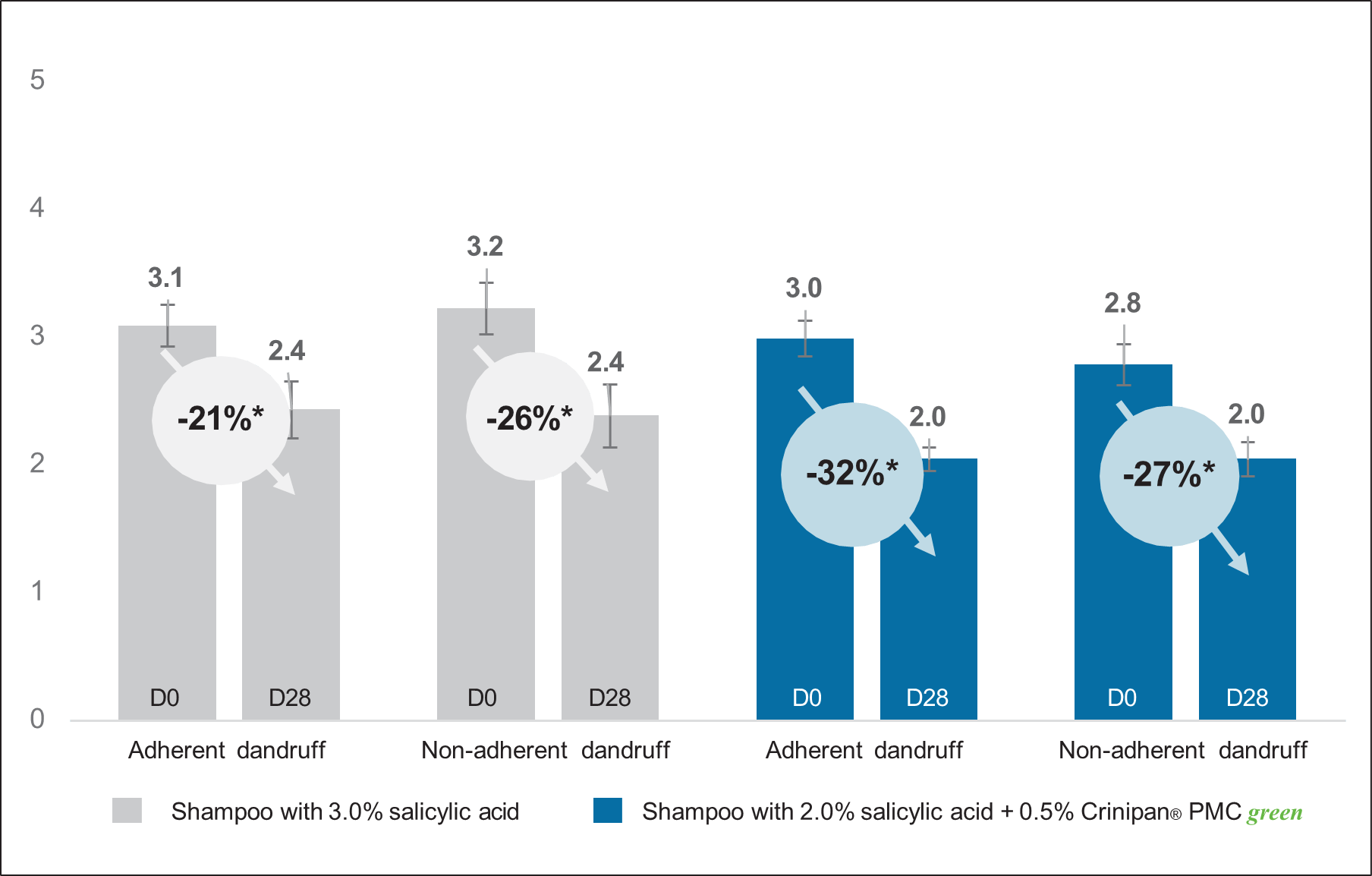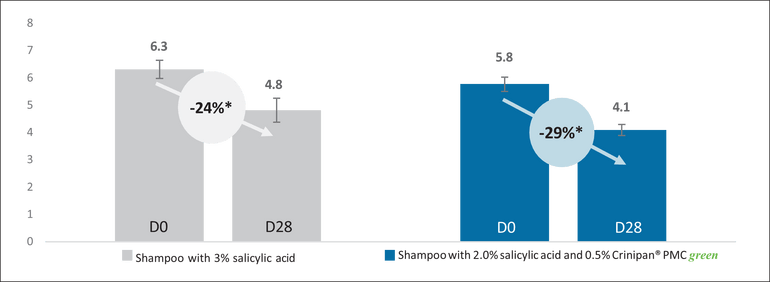
Anti-Dandruff Shampoos
The global personal care market for anti-dandruff shampoos commonly relies on the use of at least one of the following three ingredients linked to dandruff control: zinc pyrithione, piroctone olamine, and climbazole.¹ While these conventional anti-dandruff actives primarily aim to limit Malassezia’s excessive activity on the scalp, there is a fourth ingredient that is very frequently used: Salicylic acid. Initially identified and derived from willow trees (salix alba, hence the name), salicylic acid has a long history of safe use in medicine and skin care treatments. It is even listed on the World Health Organization’s List of Essential Medicines2 as one of the most important medicinal ingredients in the world. When used in shampoo, salicylic acid is applied particularly for its keratolytic effect, supporting the removal of excessive dead skin flakes (dandruff) from the scalp.
In Europe, “anti-dandruff” is a regular cosmetic claim that is subject to the generic rules from the EU cosmetic regulation. Stricter rules apply in the US as only zinc pyrithione and salicylic acid are positively listed as actives (OTC) out of the above-mentioned ingredients. The US monograph determines the following rules for active ingredients for the control of dandruff that are applicable to shampoo: Pyrithione zinc, 0.3 to 2 percent when formulated to be applied and then washed off after brief exposure or salicylic acid, 1.8 to 3 percent.3 These are already strict limitations for the US market but producers of anti-dandruff products could face even more pressure considering the March 2022 ban of zinc pyrithione from European cosmetics and its expected global impact.4 As a consequence, it can be anticipated that anti-dandruff shampoos in the US will have to rely more and more on the use of salicylic acid as the active ingredient.
Advancing Dandruff Control
Considering salicylic acid rather as a keratolytic agent, a combination with additional beneficial ingredients to enhance shampoo effectiveness and consumer acceptance will be advantageous. In this publication, we are presenting new data for the improved anti-dandruff performance of salicylic acid in shampoo applications.
Symrise has recently introduced the next generation of anti-dandruff actives from natural origin to the market. Propanediol caprylate (Crinipan® PMC green) is a renewable ester (technology) for dandruff control applications.5, 6, 7 We have previously reported on its effectiveness in various in-vivo studies. These results include improvements in the scalp condition for a healthier ratio of the natural skin microbiome.7 Crinipan® PMC green achieved a superior performance versus placebo5, as well as comparable results versus both positive controls climbazole6 and piroctone olamine1. It was also confirmed to improve the sensory performance of skin and hair.7 Combinations with piroctone olamine even showed promising results to ensure long-lastingness.1
| Aqua | 69.95 | 68.05 |
| Aqua Sodium Laureth Sulfate Lauryl Glucoside | 17 | 17 |
| Cocamidopropyl Betaine | 5 | 5 |
| Aqua Sodium Hydroxide | 2 | 3 |
| Aqua Citric Acid | 2 | 2.4 |
| Sodium Chloride | 0.75 | 0.75 |
| Sodium Benzoate | 0.5 | 0.5 |
| Polyquaternium-10 | 0.2 | 0.2 |
| Sodium Gluconate | 0.1 | 0.1 |
| Propanediol Caprylate (Crinipan® PMC green) | 0.5 | – |
| Salicylic acid | 2.0 | 3.0 |
used for the in-vivo comparison study featuring salicylic acid and
Crinipan® PMC green
Producers of shampoo applications have already discovered the potential of the combination of salicylic acid and propanediol caprylate and the first products have been launched in the cosmetics market: Mibelle’s Lee Stafford Scalp Love Surge of Moisture Shampoo 8 was identified in the UK market in March 2021, and Thornton & Ross’ Nizoral Anti-Dandruff Daily Prevent Shampoo9 is another example from January 2023 in the UK.
Taking into consideration the restricted use levels for salicylic acid in US anti-dandruff shampoos, we systematically investigated the anti-dandruff performance of shampoo in this regulated field.
Two identical base formulations, one containing salicylic acid at its maximum dose of 3% versus the second formulation featuring a reduced salicylic acid dose of 2% in combination with 0.5% propanediol caprylate were explored in a new in-vivo rinse-off shampoo study.
Superior effectiveness of salicylic acid-based anti-dandruff shampoos by addition of Crinipan® PMC green
A randomized blind study comparing a simplified standard shampoo using 3% salicylic acid as positive control versus a second shampoo containing a reduced level of 2% salicylic acid and 0.5% propanediol caprylate was performed. It should be noted, that the addition of propanediol caprylate in a shampoo with salicylic acid is stable from a pH of 4.5 to 7.
Either salicylic acid alone or the combination of salicylic acid and propanediol caprylate were added to two separate, but identical clear and unperfumed sodium laureth sulfate shampoo bases at the respective use levels (Table 1). 44 selected volunteers with oily scalp and dandruff followed a 14 days pre-conditioning procedure in which they were only allowed to wash their hair with a standardized neutral market shampoo. This was previously provided by the external institute and did not contain any active ingredient.





After the pre-conditioning phase, 22 subjects applied the salicylic acid (positive control) shampoo, and the remaining 22 subjects applied the test shampoo with a combination of salicylic acid/propanediol caprylate. The test shampoos were applied at least 3 times a week. The visual dandruff score was rated in the test institute before the first application (D0) and at the end of the study after 28 days (D28) of application. An expert rating of nonadherent as well as adherent dandruff was performed on a 0 to 5 visual scale (Figure 1). Their sum represents the total dandruff score on a 0 to 10 scale (Figure 2).
While there is no significant difference between the performance of both shampoos in reducing the non-adherent dandruff, there is a remarkable difference between the shampoos for reducing the adherent dandruff in favor of the shampoo with the active combination (Figure 1). It reduced adherent dandruff by 32% while the positive control only showed a reduction of 21%. This led to a better reduction of the total dandruff score for the group that used the shampoo containing both salicylic acid and propanediol caprylate (Figure 2). Nonetheless, both treatments showed an anti-dandruff effect with a significant reduction of dandruff vs. D0.
Interestingly, 100% of the subjects using the shampoo with a reduced level of 2% salicylic acid combined with 0.5% propanediol caprylate observed a reduction of their dandruff while only 91% of the subjects from the positive control (3% salicylic acid alone) group experienced such a result.
The erythema score and the irritation score also showed a significant reduction after 28 days for both shampoos. The shampoo with the reduced level of salicylic acid combined with propan-ediol caprylate showed again a stronger decrease of 57% (vs. 33–39%) in both scores (Figure 3).
The participants were then asked to answer a questionnaire to evaluate the sensory performance of the shampoo (Figure 4). Overall, the shampoo containing the combination of the actives was rated better by the participants than the shampoo containing salicylic acid alone.
As salicylic acid is a listed preservative in Annex V of the European Cosmetic Regulation, the synergism of the combination with propanediol caprylate for preservative efficacy was also studied (Figure 5). While a shampoo with 0.5% salicylic acid meets criteria B of the European Pharmacopeia, a shampoo containing a reduced level of salicylic acid (0.25%) and 0.25% of propanediol caprylate even meets criteria A.
Conclusion
These new in-vivo results demonstrate that salicylic acid’s anti-dandruff performance in shampoo can be improved by the addition of our next-generation ester technology Crinipan® PMC green (propanediol caprylate). By the addition of propanediol caprylate, it is even possible to reduce the dose of salicylic acid while observing a stronger reduction of dandruff and an enhanced preservation efficacy. Furthermore, an improved overall sensorial performance of the product was observed for the shampoo containing this ingredients’ combination.
The combination of salicylic acid and Crinipan® PMC green is particularly relevant for the North American market due to salicylic acid´s listing in the US FDA monograph for dandruff control but could also be of high interest in other markets like Europe.
References
- Genrich, F., Meunier, L., Nordzieke, S. (Oct. 2022) The Green Future of Dandruff Control; Personal Care Magazine Global, 64-68.
- World Health Organization Model List of Essential Medicines, 21st List (2019) https://apps.who.int/iris/bitstream/handle/10665/325771/WHO-MVP-EMP-IAU-2019.06-eng.pdf?sequence=1&isAllowed=y
- US Food&Drug Administration (FDA) (Dec 16, 2021) https://www.accessdata.fda.gov/drugsatfda_docs/omuf/OTC%20Monograph_M032-Drug%20Products%20for%20the%20Control%20of%20Dandruff%20Seborrheic%20Dermatitis%20and%20Psoriasis%2012.16.2021.pdf
- COMMISSION REGULATION (EU) 2021/1902 of 29 October 2021 amending Annexes II, III and V to Regulation (EC) No 1223/2009 of the European Parliament and of the Council as regards the use in cosmetic products of certain substances classified as carcinogenic, mutagenic or toxic for reproduction: https://eur-lex.europa.eu/legal-content/EN/TXT/?uri=CELEX%3A32021R1902&qid=1635933838171
- Genrich, F., Koch, C., Lange, S., Bugdahn, N., Schmaus, G. (Dec. 2020). Next Generation Dandruff Control; SOFW-Journal 146 8-13.
- Genrich, F., Nordzieke, S. (April 2021) Shaping the Future with Green Dandruff Control; Euro Cosmetics 29, 16-18.
- Genrich, F., Koch, C., Massironi, M., Thomaz, F. (June 2021) Propanediol Caprylate: Shifting the Microbiome, Sebum Levels and Classic Approach to Dandruff; Cosmetics & Toiletries Vol 136; No. 6, 44-51.
- Mintel GNPD database: Record ID 8557619, Mibelle´s Lee Stafford Scalp Love Surge of Moisture Shampoo, published March 2021 in the UK.
- Mintel GNPD database: Record ID 10532496, Thornton & Ross Nizoral Anti-Dandruff Daily Prevent Shampoo, published January 2023 in the UK.



